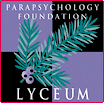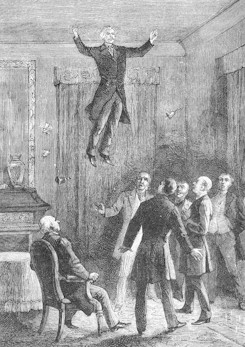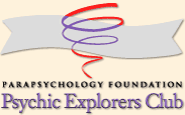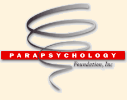 |
 |
| Carlos S. Alvarado, Ph.D. Chairman of Domestic and International Programs Parapsychology Foundation (adapted from “Historical Notes on the Role of Mediumship in Spiritualism, Psychical Research and Psychology,” paper presented at the Parapsychology Foundation Conference, The Study of Mediumship: Interdisciplinary Perspectives, held during January of 2005 in Charlottesville, Virginia) While the emphasis of the following is on mediumship in Europe and in the United States during the nineteenth and part of the twentieth centuries, we should be aware that mediumship has existed in other periods and cultures. The appearance of the professional medium in the United States in the mid-nineteenth century was preceded by a tradition of communication from the dead that stretches back into antiquity (Ogden, 2001; Paton, 1921). Furthermore, the path for modern mediumship was heralded by a variety of sonambulistic, trance, and visionary phenomena coming from both religious and lay settings. Writing in 1854, French scientist Michel Eugène Chevreul (1786-1889) believed that the aptitude Americans had shown for commerce and industry was also shown in the appearance of mediumship. “Today in the United States,” wrote Chevreul, “it is possible to be a medium as it is possible to be a businessman, an industrialist, a physician or a lawyer ...” (Chevreul, 1854/1992, p. 193, this and other translations are mine). At the time Chevreul was writing, mediums were known to produce both mental phenomena and physical effects. Mental phenomena, said to be inspired by deceased spirits, took place through speaking in and out of trance and through visions. Trance speaking included a variety of “inspired” lectures on religious, moral, philosophical and scientific topics as well as messages given to establish identity. The “spirits” also expressed themselves through the medium’s own writing and through the execution of drawings and paintings. On the physical side, in addition to rappings and table-tilting (manifestations that conveyed communications), there were such phenomena as the movement of objects (later called telekinesis), the appearance of writing on paper or slates, photography of spirits, appearance of objects seemingly transported from different places, the levitation of the medium, healing, and materializations or appearances of forms representing parts of human beings, such as faces, hands and complete bodies. The beginnings of the development of mediumship as a profession has been traced to some presumably spontaneous “knockings.” Mysterious raps took place in the home of the Fox family in Hydesville, New York, in 1848 (Capron, 1855, chapter 2). The manifestations centered around the Fox sisters, Margaretta (1836-1893) and Catherine Fox (1841-1892), and seemed to involve intelligent communications through the raps (for a recent biography of the Fox sisters see Weisberg, 2004). Mrs. Margaret Fox (1796-1865), the mother of the sisters, testified that her family heard unexplained knockings in their house at night. On one occasion early on: The girls ... heard the noise, and tried to make a similar noise by snapping their fingers. The youngest girl ... is the one who made her hand go. As fast as she made the noise with her hands or fingers, the sounds followed up in the room. It did not sound differently at that time; but it made the same number of raps the girl did. When she stopped the sounds would stop for a short time. The other girl . then spoke, in sport, and said, “Now do just as I do. Count one, two, three, four,” at the same time striking one hand in the other. The blows which she made were repeated, as before. It appeared to answer her by repeating every blow she made (Capron, 1855, p. 40). Mrs. Fox proceeded to ask if the communicator was a spirit, and the raps replied affirmatively, stating someone had been killed and buried under the house. (People testified to hearing knockings and even seeing apparitions in the same house before the Foxes moved in [Capron, 1855, pp. 33-38]. Excavations were made to corroborate the story of the communicating spirit and human teeth, bones and hair were found in the foundations of the house [Capron, 1855, p. 53].) After much publicity the sisters were sought out by people who wanted to witness the manifestations and to communicate with the dead. The raps moved from the Fox Sisters’ Hydesville home to other places where special meetings, later called seances, were held for the purpose. The sisters established a reputation as intermediaries between the earthly and the spiritual world. By 1856 the press reported that such prominent people as historian George Bancroft (1823-1899) and poet William Cullen Bryant (1794-1878) had witnessed the Fox’s phenomena (Hardinge, 1870, pp. 63-65). Their well-known performances, and the controversies they inspired led to what early historian of American Spiritualism and medium, Emma Hardinge (later Britten, 1823-1899), described in her book Modern American Spiritualism, as “the formation of circles in every other house in town, and the rapid development of media in every other family” (Hardinge, 1870, p. 65). Professional mediums were soon great in number. Writing about four years after the beginnings of the Fox sisters’ career, prominent American spiritualist Judge John W. Edmonds (1799-1874) wrote: “Then mediums could be counted by the units, but now by thousands” (Edmonds & Dexter, 1854, p. 78). By 1853, it was estimated that there were 30,000 mediums in the United States (Howitt, 1863, Vol. 2, p. 196). Mediums were instrumental in the expansion of the spiritualist movement by presenting a wide variety of effects. The “spirits,” through the mediums, communicated in forms guaranteed to attract the attention of the public and in ways with which organized religion and other movements could not compete. While there were experiential dimensions in religious revivals and in mystical and conversion experiences (Taves, 1999), in general organized religion depended mainly on the faith of the clergy and on each religion’s central book. Mediums provided immediate phenomena, on demand and fast, creating what seemed to be empirical evidence for a spiritual reality. Furthermore, through mediumship, the common individual had personal access to that reality. In the words of historian Bret E. Carroll, Spiritualism “democratized spirit communication and access to the religious authority of higher spiritual beings” (Carroll, 1997, p. 24). One example of this was what Epes Sargent (1813-1880), an early popularizer of Spiritualism in the United States, referred to as “proof palpable of immortality” (Sargent, 1875). This was a reference not only to the physical “palpable” nature that anyone in theory could verify through materializations, but also to the actual implications of the manifestations, namely the “proof” it seemed to provide for the idea of survival of death and the possibility of communication with spirits. Through their phenomena, mediums became the ambassadors of the new movement. Their performances informed society of the existence of the phenomena of Spiritualism and reinforced the idea that humans were in essence spiritual beings. An example was the celebrated Daniel Dunglas Home (1833-1886) pictured below in a famous illustration of the medium levitating in front of witnesses at a seance.  Because of his extensive travels and the wide range of his phenomena, Home was a particularly important ambassador for the cause of Spiritualism and for the existence of psychic phenomena (on the life and travels of this medium see Jenkins, 1982). Home became known in the United States for both physical phenomena, and spirit communications. In a séance in Hartford sitters claimed to have heard many dramatic sounds: “Some of the blows on the walls, floor and tables, within three inches of myself, were astounding ... The very walls shook” (Curious Phenomena, 1852). Because of his extensive travels and the wide range of his phenomena, Home was a particularly important ambassador for the cause of Spiritualism and for the existence of psychic phenomena (on the life and travels of this medium see Jenkins, 1982). Home became known in the United States for both physical phenomena, and spirit communications. In a séance in Hartford sitters claimed to have heard many dramatic sounds: “Some of the blows on the walls, floor and tables, within three inches of myself, were astounding ... The very walls shook” (Curious Phenomena, 1852).
Home traveled to England where he had seances during the 1850s with such personalities as scientist David Brewster (1781-1868), writer Edward Bulwer Lytton (1803-1873), poets Elizabeth (1806-1861) and Robert Browning (1812-1889), and politician Lord Henry Brougham (1778-1868). Accounts of Home’s phenomena, together with criticisms and suspicions of fraud, spilled into the press and captured the popular imagination. Later in France, Home produced phenomena for Emperor Napoleon III and the Empress Eugènie that created much discussion and speculation. More publicity for this medium and his phenomena came when Home was expelled from Rome in 1864. The London Times published a letter from Home in which he claimed that Italian authorities had asked him to sign documents in which he stated that he had neither sold his soul nor communicated with the “Evil One” (Home, 1864). In England Home’s career was the center of two influential books. In one that was printed privately, Experiences in Spiritualism with D.D. Home, Lord Adare (1841-1926) presented observations he made of Home’s phenomena for the period 1867-1869 (Dunraven, 1869/1924). Later, physicist William Crookes (1832-1919) reported experiments conducted with Home in the early 1870s in his classic Researches into the Phenomena of Spiritualism (Crookes, 1874). Home’s influence on these and other important persons provided the medium with a unique opportunity to spread Spiritualism through his phenomena. Much of what mediums communicated was non-evidential, including messages supposedly coming from famous philosophers, writers and scientists on such varied topics as life in the spirit world, the nature of the spiritual and the material worlds, philosophy, and morality. In fact, such communications from famous personalities became a prominent part of Spiritualism and its image in the minds of the public at large. An example were the purported communications from Swedenborg and Bacon recorded by Judge Edmonds and by physician George T. Dexter in their influential and frequently reprinted book simply entitled Spiritualism (Edmonds & Dexter, 1854). In his discussion of American spiritualistic phenomena, Sights and Sounds, Henry Spicer (1853) recorded communications from George Washington (pp. 145-146), Thomas Jefferson (pp. 146-147), Calvin (pp. 147-148), and Fénelon (pp. 148-150). French theologian François Fénelon (1651-1715) was also said to communicate in France. In the preface of his first book on spiritism that focused on the philosophy of the movement, as communicated through different French mediums, Allan Kardec (the pseudonym of Hippolyte Léon Dénizard Rivail, 1804-1869) listed Fénelon and others as the sources of the teachings (Kardec, 1867). Other communicating spirits included St. Augustine, Socrates, Plato, and Benjamin Franklin. But Kardec also paid attention to less prominent spirit communicators. An overview of the first volume of his journal, Revue spirite, published in 1858, shows published messages said to come from an executed murderer, an insane person, and a suicide. Furthermore, there are many other examples of mediumistic communications that helped spread the movement of Spiritualism (and spiritism) and maintained belief in the possibility of communication from the beyond. In her book From Matter to Spirit, published in London in 1863, Sophia de Morgan (1809-1892) claimed that in communications received in England through medium Emma Jay, her “voice and manner differed much when under different influences” (De Morgan, 1863, p. 90). Other mediums produced spirit drawings (Wilkinson, 1858), poetry (“Rifts in the Veil,” 1878) and played music. For example, in a séance in England it was stated that Mr. Hearne played the piano in a semi-trance condition in which he “brought out melodies and harmonies the ideas in which were infinitely above the rendering through his fingers ...” (Berry, 1876, p. 50). In addition, Spiritualism benefited greatly when mediums produced veridical messages. Such messages contained evidence of identity particularly impressive to those sitters who sought to contact their dead loved ones. For example, Robert Cooper (1844-1903), in his book Spiritual Experiences (1867), wrote: I have had ... the most satisfactory proofs of identity in the case of my wife ... The communications were perfectly characteristic of herself and when made in writing exactly corresponded with her original chirography. Besides on one occasion, she addressed me by a name she was in the habit of calling me, which name I had not thought of for years, and I did not at first recognise it (Cooper, 1867, p. 75). In addition to aiding in the dissemination of the movement of Spiritualism through their travels around the United States, Europe and elsewhere, mediums were also instrumental in the development of the more philosophical aspect of the movement, providing teachings that asserted the spiritual nature of humankind, the existence of God, and many other issues relevant to human existence and the afterlife (e.g., Edmonds & Dexter, 1854; Kardec, 1867; Moses, 1883). In an early book, it was stated that the soul was “an emanation from the germ of the great First Cause, so its destiny is to return toward the source where it sprang” (Edmonds & Dexter, 1854, p. 64). While I have emphasized nineteenth century developments, it is important to recognize that mediums have continued to shape Spiritualism and spiritual beliefs into more recent times. The performances of modern mediums have continued to inspire many in their beliefs in the spirit world and survival of death. Berry, C. (1876). Experiences in Spiritualism: A record of extraordinary phenomena witnessed through the most powerful mediums (2nd enlarged ed.). London: James Burns. Capron, E. W. (1855). Modern Spiritualism: Its facts and fanatisms, its consistencies and contradictions. Boston: Bela Marsh. Carroll, B. E. (1997). Spiritualism in antebellum America. Bloomington: Indiana University Press. Chevreul, M. E. (1992). De la varilla adivinatoria del péndulo llamado explorador y de las mesas giratorias desde el punto de vista de la historia de la crítica y del método experimental [On the divining rod, the so called explorer pendulum and turning tables from the point of view of the history of criticism and experimental method] (J. Guerrera Escofet, trans.). Barcelona: Editorial Humanitas. (Original work published, 1854) Cooper, R. (1867). Spiritual experiences, including seven months with the brothers Davenport. London: L. Heywood. Crookes, W. (1874). Researches in the phenomena of Spiritualism. London: J. Burns. Curious phenomena — Spiritual rappings — An interesting narrative. (1852, August 16). New York Daily Times, p. 4. [De Morgan, S. E.] (1863). From matter to spirit: The result of ten years' experience in spirit manifestation. London: Longmans, Green, & Roberts. Dunraven, Earl of. (1924). Experiences in Spiritualism with D. D. Home. Proceedings of the Society for Psychical Research, 35, 1-285. (Original work published, 1869) Edmonds, J. W., & Dexter, G. T. (1854). Spiritualism (9th ed.). New York: Partridge & Brittan. Hardinge, E. (1870). Modern American Spiritualism: A twenty year's record of the communion between earth and the world of spirits (3rd ed.). New York: Author. Home, D. D. (1864b, February 6), Spiritualism in Rome. The Times, p. 7. Howitt, W. (1863). The history of the supernatural in all ages and nations and in all churches christian and pagan demonstrating a universal faith (2 vols.). Philadelphia: J.B. Lippincott. Jenkins, E. (1982). The shadow and the light: A defence of Daniel Dunglas Home. London: Hamish Hamilton. Kardec, A. (1867). Philosophie spiritualiste: Le livre des esprits: Contenant les principles de la doctrine spirite [Spiritualist philosophy: The book of spirits: Containing the principles of the spiritist doctrine] (15th ed.). Paris: Didier. [Moses, W. S.]. (1883). Spirit teachings. London: Psychological Press Association. Ogden, D. (2001). Greek and Roman necromancy. Princeton: Princeton University Press. Paton, L. B. (1921). Spiritism and the cult of the dead in antiquity. New York: Macmillan. “Rifts in the veil:” A collection of inspirational poems and essays given through various forms of mediumship. (1878). London: W.H. Harrison. Sargent, E. (1875). The proof palpable of immortality: Being an account of the materialisation phenomena of modern Spiritualism. Boston: Colby & Rich. Spicer, H. (1853). Sights and sounds: The mystery of the day: Comprising an entire history of the American “spirit” manifestations. London: Thomas Bosworth. Taves, A. (1999). Fits, trances, & visions: Experiencing religion and explaining experience from Wesley to James. Princeton: Princeton University Press. Weisberg, B. (2004). Talking to the dead: Kate and Maggie Fox and the rise of Spiritualism. San Francisco: HarperSanFrancisco. (Available on Psi-Mart at this link.) Wilkinson, M. M. (1858). Spirit drawings: A personal narrative. London: Chapman and Hall. |
 |

|
 www. parapsychology. org |
||